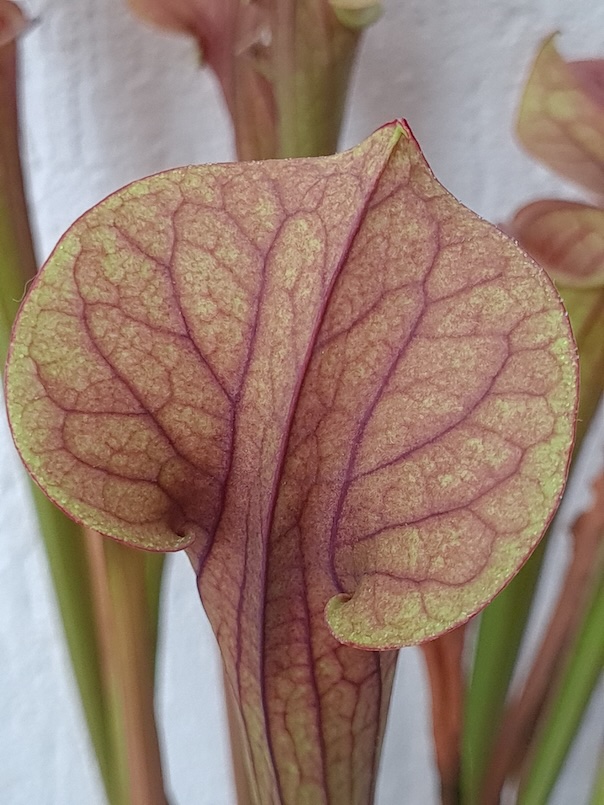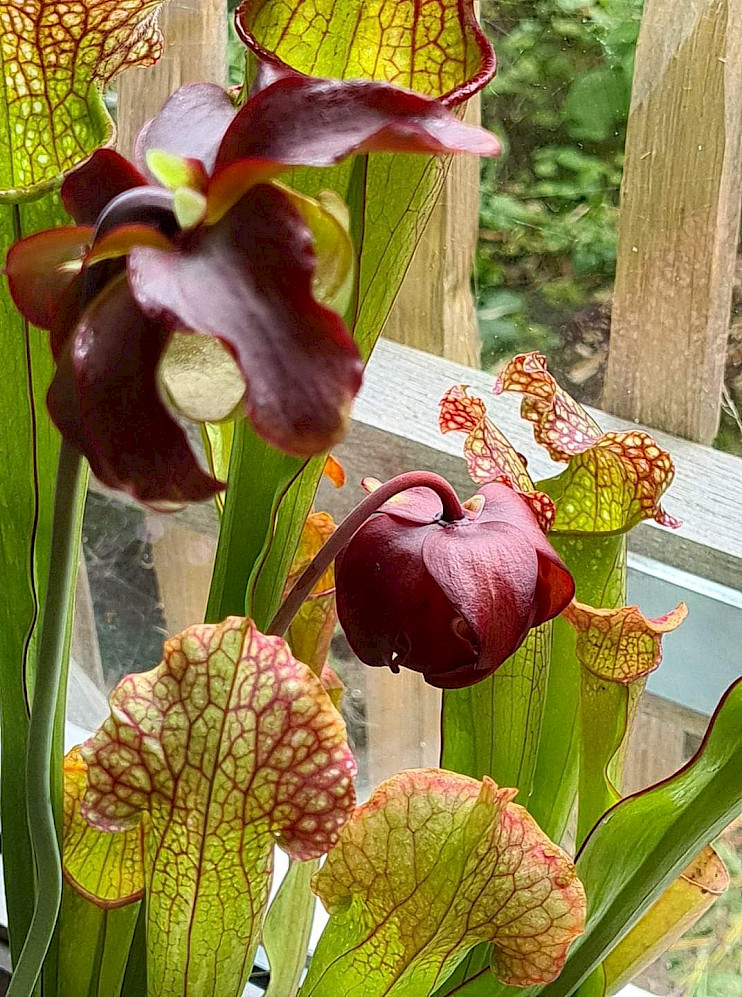

Sarracenia x ‘Velvet’
General
Sarracenia x ‘Velvet’ is a cultivated hybrid of North American pitcher plants, prized for its rich, velvety texture and striking coloration. Like its relatives in the Sarracenia genus, it is a carnivorous plant that attracts, traps, and digests insects to thrive in nutrient-poor conditions. This hybrid is sought after by collectors for its robust growth and remarkably ornamental presence.
Physical Characteristics
The pitchers (modified leaves) of this plant are upright, slender, and typically reach heights of 25–40 cm (10–16 in), depending on maturity and growing conditions. They display a velvety, matte finish with deep burgundy to dark purple hues, sometimes showing contrasting veins or a lighter peristome (lip). The hood is elegantly arched, shading the pitcher mouth and enticing prey with nectar. In late spring or early summer, Sarracenia x ‘Velvet’ may produce a single dangling flower per growing point, often in shades of maroon or crimson.
Lifestyle
This is a passive pitfall trapper: insects are drawn by nectar, slide into the tall tubular leaves, and are unable to escape due to downward-pointing hairs and slippery inner walls. Enzymes and bacteria break down the prey, providing essential nutrients.
Habitat and Protection
Native Sarracenia typically grow in the acidic, boggy wetlands of the southeastern United States. Although Sarracenia x ‘Velvet’ is a horticultural hybrid, it inherits a preference for similar wet and sunny conditions. In the wild, Sarracenia habitats are under threat from development, pollution, and poaching, making cultivated hybrids important for conservation. Always obtain plants from reputable nurseries, not wild collection.
Cultivation
This hybrid is well-suited for outdoor bog gardens in temperate climates, but can also be grown in greenhouses or sunny windowsills. It requires consistently moist, acidic soil and plenty of light. With proper care, this plant thrives and becomes a standout specimen in any collection.
Special Features
The standout qualities include the uniquely velvety surface of its pitchers and its deep, rich coloring, which is not only beautiful but also serves to lure prey. The plant is also relatively vigorous and forgiving compared to some pure species, making it suitable for beginners who want to explore carnivorous plants.
Care
Light
Full sun is ideal; provide at least 6 hours of direct sunlight daily. Indoors, use strong grow lights if natural light is insufficient.
Temperature
It tolerates a wide range, thriving in summer temperatures from 20–30°C (68–86°F) and tolerating cool winter dormancy periods down to 0–5°C (32–41°F).
Water
Always keep the soil moist with rainwater, distilled, or reverse osmosis water. Avoid tap water, which can accumulate harmful minerals. Set the pot in a water tray during the growing season.
Soil
Use a mix of sphagnum peat moss and perlite (or silica sand), in a ratio of about 2:1. Do not add compost, standard potting soil, or any fertilizer-containing medium.
Nutrition
This hybrid obtains nutrients from insects. Do not fertilize; if grown indoors where there are no insects, offer the occasional small bug, but never feed with human food scraps.
Humidity
Moderate to high humidity (above 50%) is best, but it is fairly adaptable. Avoid placing near heating or cooling vents that will dry the air.
Dormancy
A winter dormancy period is essential. Growth will cease in late autumn. Reduce watering (keep soil just damp) and provide cooler temperatures (close to 0–5°C/32–41°F) for 3–5 months. Normal care resumes in spring.
Common Problems
Pitchers wilt and collapse
Cause: Dehydration or insufficient light.
Solution: Ensure soil is always moist and move plant to a sunnier spot if needed.
New growth is weak, spindly, and pale
Cause: Inadequate light or over-fertilization.
Solution: Provide more direct sunlight and never fertilize.
Pitchers turn brown at the base
Cause: Natural aging or winter dormancy.
Solution: Trim away old pitchers in early spring; this is normal and not a disease.
White powdery patches on pitchers
Cause: Powdery mildew due to poor air circulation or overly damp, stagnant conditions.
Solution: Increase air circulation, reduce humidity slightly, and treat with a fungicide safe for carnivorous plants.
No traps or stunted growth during spring/summer
Cause: Insufficient winter dormancy or improper temperatures.
Solution: Ensure plant receives 3–5 months of cool dormancy each year.
